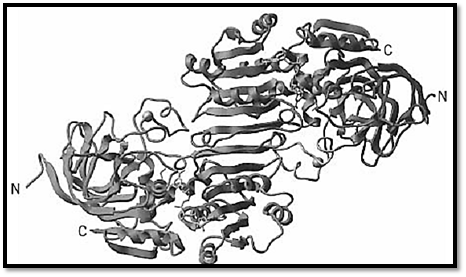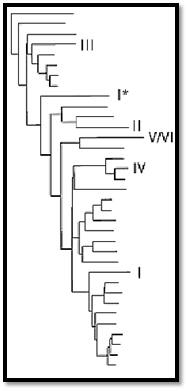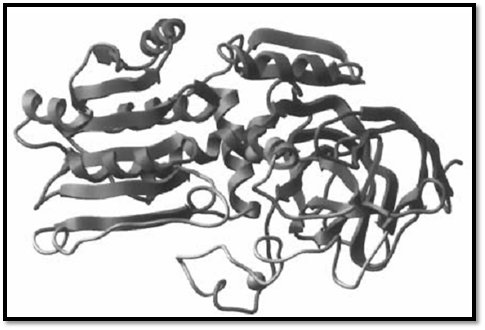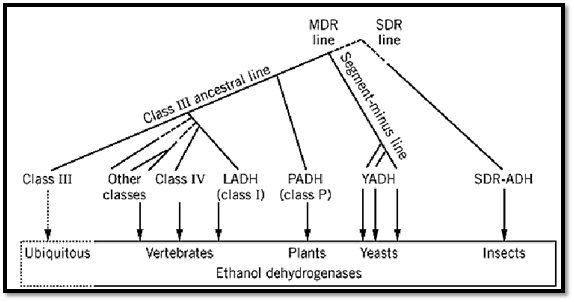


 النبات
النبات
 الحيوان
الحيوان
 الأحياء المجهرية
الأحياء المجهرية
 علم الأمراض
علم الأمراض
 التقانة الإحيائية
التقانة الإحيائية
 التقنية الحيوية المكروبية
التقنية الحيوية المكروبية
 التقنية الحياتية النانوية
التقنية الحياتية النانوية
 علم الأجنة
علم الأجنة
 الأحياء الجزيئي
الأحياء الجزيئي
 علم وظائف الأعضاء
علم وظائف الأعضاء
 الغدد
الغدد
 المضادات الحيوية
المضادات الحيوية|
Read More
Date: 7-12-2015
Date: 19-5-2016
Date: 27-4-2016
|
Alcohol Dehydrogenase (ADH)
ADH is a type of enzyme that catalyzes the reversible interconversion of an alcohol to an aldehyde/ketone [EC 1.1.1.1]. The substrate specificity is often wide, but it typically includes at least some activity with ethanol. The coenzyme is often NAD+. ADH was initially purified from yeast )YADH) and from horse liver (LADH), sources from which it is commercially available. It is, however, now known to be widespread, with at least some forms present in eukaryotes, prokaryotes and archaeabacteria in general. It has been well studied at the protein and DNA levels from many sources. The “classical” forms of ADH are Zn-containing metalloproteins with subunits of ~40 kDa (~350 to 390 residues) (1). They are now considered part of a larger protein family (see Protein Evolution), known as medium-chain dehydrogenases/reductases (MDR) (2).
Although ADH is frequently regarded as well understood, much is still unknown, and novel findings of general interest are constantly obtained:
1. ADH is no longer just an enzyme, but a whole system of great complexity, involving other protein families and a multiplicity of MDR forms.
2. another such family is (short-chain dehydrogenases/reductases) SDR (3). The major ADH of insects is this type, and SDR enzymes are numerous, including hormone-converting and regulatory enzymes in humans and all living forms.
3. MDR-ADH occur as different classes (4) and isozymes. They exhibit distinct evolutionary patterns, repeated evolutionary origins, and varying properties. At least six classes and eight genes have been discerned in mammals, but these numbers are likely to grow; they differ among species because of recent gene duplications. Expressions differ with organ, tissue, and age, including special fetal forms.
4. Functionally, the ADH system has long been an enigma, but recent results suggest that it has important roles. Metabolically, ADH is associated with aldehyde dehydrogenase, which is part of another large family. Medically, both activities are important in alcohol metabolism and in several disease states but also in vision and in cellular regulation and differentiation (5, 6).
1. MDR-ADH
1.1. Classes in Vertebrates
Mammals and most vertebrates contain different classes of MDR Zn-containing ADH enzymes. These classes differ substantially in substrate specificity and in their immunological, chromatographic, and electrophoretic properties (4). They constitute separate forms that are intermediate in their properties between isozymes and distinctly different enzymes, and they differ in primary structures by about 30% but have closely related conformations (Fig. 1). The classes reflect a series of gene duplications, which occurred largely at early vertebrate times (8). Later duplications in individual lines have given rise to intraclass isozymes. The subunits of isozymes can hybridize into mixed dimers that reflect the subunit mixture, but those of different classes do not.

Figure 1. Structure of human ADH class I (7). The diagram and the modeling of ethanol were made with the program ICM (Molsoft, Metuchen, NJ) from coordinates in the data bank.
Class I contains the classical ADH enzyme, which is present in large amounts in liver but in lower amounts in many other organs. It is involved in ethanol metabolism and in liver function. It has good enzymatic activity with primary alcohols, cyclohexanol, retinols, and many other alcohols, plus their corresponding aldehydes. Isozymes occur and are largely species specific. The horse ADH subunits E and S derive from two separate genes and the human subunits a, b, and g from three genes. The a subunit is expressed in the fetus and b and g in the adult. The b and g types also exhibit further variability from alleles that have different population distributions in Caucasians and Orientals. This population variation, together with other alleles of the next enzyme of alcohol metabolism (aldehyde dehydrogenase), explains the different sensitivity to ethanol consumption of Caucasians and Orientals.
Class II ADH is highly variable. It is also expressed in the liver but in lower amounts. Thus far it is without a recognized functional role, but in humans it has a higher Km for ethanol, and hence is of little importance in ethanol metabolism.
Class III ADH is expressed universally in cells and organs, and is identical to glutathione (GSH)-dependent formaldehyde dehydrogenase (EC 1.2.1.1). In the absence of GSH, it is a dehydrogenase toward long-chain alcohols and is largely inactive with ethanol. The Km for ethanol is >3 M , so there is activity only at high ethanol concentrations. In the presence of GSH, class III ADH is active with the GSH/formaldehyde adduct, hydroxymethyl-GSH, when it functions as a formaldehyde dehydrogenase, producing formic acid.
Class IV ADH is present in the stomach and in skin (epithelia). It is the most ethanol-active form and has been discussed in relation to first-pass ethanol metabolism and to retinol dehydrogenase function. Both roles, however, are far from established.
Little is known about the remaining enzyme classes in vertebrates.
Class III is the evolutionary ancestor, which is apparent from phylogenetic trees (Fig. 2), the rates of change in present forms, and in apparently being the only MDR-ADH in invertebrates. However, final judgment of the phylogeny must await characterization of further forms. Additional gene duplications probably remain to be discovered, and the true evolutionary relationships may be complex, involving both extant and extinct forms.

Figure 2. Evolutionary tree of animal ADH. The deviating class I form of bony fish is indicated by a star. The tree was calculated using ClustalW (2) with corrections for multiple substitutions.
In molecular terms, the classes exhibit different evolutionary patterns. Class III is like an enzyme of basic metabolism, and has relatively constant functional properties among species and variation primarily in the nonfunctional parts of the protein (Fig. 3). Class I is the result of an early gene duplication from class III, whereas class IV in turn diverged from the class I line. Special hybrid forms of class I/III (in fish), II/I (in birds) and IV/I (in amphibians) have been traced and may reflect either the phylogeny or simply additional gene duplications. In short, the ADH system has many interesting evolutionary features (8).

Figure 3.
1.2. Yeast, Plants, Other Nonvertebrate Forms
Nonvertebrate MDR-ADH are also frequent and have at least two classes. One is the class III enzyme, which has GSH-dependent formaldehyde dehydrogenase activity, as expected from the ancestral properties noted previously. The other is ethanol-active MDR-ADH: yeast ADH (YADH, from at least three genes) and plant ADH (PADH). YADH has greater ADH activity than LADH because of weaker coenzyme binding and consequently a greater turnover rate, because coenzyme dissociation is the rate-limiting step. Although YADH and PADH are related to LADH structurally and functionally, they are products of gene duplications separate from that leading to class I ADH. Combined, all of these ethanol-active forms suggest that ADHs active with alcohol have arisen several times during evolution, probably by functional convergence. Presumably all or many of these ethanol-active forms are derived from the ancestral class III line (Fig. 4), but they can differ in quaternary structure. Ethanol-active YADH is a tetramer, whereas yeast class III ADH is a dimer.

Figure 4. Functional convergence toward ethanol dehydrogenases in different lines of living organisms, emphasizing the repeated appearance of ethanol-activity, many separate gene duplications, and an apparent MDR-ancestral nature of class III. Dashed lines indicate unknown relationships, and dotted lines low activity with ethanol. Segment-minus forms lack internal segments (Fig. 1) and are tetrameric. The remaining forms are dimers. Apart from the gene duplications shown, which lead to ethanol-active dehydrogenases, additional branchings lead to cinnamyl ADH (in plants), sorbitol dehydrogenase (in animals), threonine dehydrogenase (in prokaryotes), several reductases (in prokaryotes and eukaryotes), and additional enzymes.
1.3. Function
Liver ADH (class I) is the major metabolic enzyme for ethanol, either ingested or produced in the intestine, and for other alcohols. Overall, the formaldehyde specificity of the ancestral form (class III), the multiplicity of all ADH systems, and the gradual changes in substrate specificity suggest that the whole ADH system is a basic enzyme, together with aldehyde dehydrogenase, in cellular defense reactions against alcohols and aldehydes, converting them to acidic end products. The validity of this general role of ADH is supported by the fact that the only animals apparently lacking ADH (except for formaldehyde-active class III) are marine invertebrates (10), whose environment is low in alcohol and aldehyde levels. The formaldehyde dehydrogenase activity of class III ADH is universal and constant throughout the living world, although the Km and enzymatic efficiencies are increased in microorganisms. This permits life at higher aldehyde concentrations (11) and suggests a general defense function for the ADH system.
Additional functions of individual classes are likely. Class IV has been discussed relative to its possible role in retinal formation important for rhodopsin and vision (6) and in retinoic acid formation, which important for vertebrate growth and differentiation (5). Similarly, special forms of ADH and aldehyde dehydrogenase are involved in the fatty acid cycle in dermal wax and plasmalogen formation in the central nervous system and are associated with an inborn error of metabolism (Sjögren-Larsson syndrome) affecting the corresponding genes (12).
1.4. Other MDR Enzymes
Many enzymes active on other alcohols or polyols are related to MDR-ADH in structure and origin. Among these are sorbitol dehydrogenase, threonine dehydrogenase, quinone oxidoreductase, the enoyl reductase component of the fatty acid synthesis machinery, and enzymes with undefined functions, like VAT-1 of synaptic membranes (2). These enzymes are similar conformationally and in their overall active-site relationships. But they also differ markedly, including functionally, in that all do not have the active-site zinc typical of MDR-ADH. This suggests that they have different enzymatic mechanisms. Zinc is also absent in quinone oxidoreductase, which is a crystallin in ocular lenses of some animals.
2. SDR-ADH
Insect ADH is the only well known SDR-ADH, but hundreds of other SDR enzymes are known. These enzymes work on hydroxyl groups of a multitude of sugar, steroid, prostaglandin, and other compounds. They also include reductases, with other activities (like double-bond saturation), and enzymes of no less than three of the enzyme classes in general (oxidoreductases, lyases, and isomerases (3)).
3. Other ADH Forms
ADH activity is also known in enzymes other than the MDR and SDR forms, including iron-activated forms (13). Prokaryotes have several different forms, including long-chain alcohol dehydrogenases (14) and methanol dehydrogenases. They may even have MDR relationships, and this definitely applies to other special prokaryotic forms, such as factor-dependent formaldehyde DH (15), which is apparently the equivalent of class III MDR-ADH in Gram-positive bacteria.
References
1. C.-I. Brändén, H. Jörnvall, H. Eklund, and B. Furugren (1975) The Enzymes, 3rd ed., chap. "11", pp. 103–190.
2. B. Persson, J. S. Zigler Jr., and H. Jörnvall (1994) Eur. J. Biochem. 226, 15–22.
3. H. Jörnvall et al. (1995) Biochemistry 34, 6003–6013.
4. B. L. Vallee and T. J. Bazzone (1983) Curr. Top. Biol. Med. Res. 8, 219–244.
5. G. Duester (1996) Biochemistry 35, 12221–12227.
6. A. Simon et al. (1995) J. Biol. Chem. 270, 1107–1112.
7. T. D. Hurley et al. (1994) J. Mol. Biol. 239, 415–429.
8. O. Danielsson et al. (1994) Proc. Natl. Acad. Sci. USA 91, 4980–4984.
9. J. D. Thompson, D. G. Higgins, and T. J. Gibson (1994) Nucleic Acids Res. 22, 4673–4680.
10. M. R. Fernández et al. (1993) FEBS Lett. 328, 235–238.
11. M. R. Fernández et al. (1995) FEBS Lett. 370, 23–26.
12. V. De Laurenzi et al. (1996) Nature Genet., 12, 52–57.
13. R. K. Scopes (1983) FEBS Lett. 156, 303–306.
14. T. Inoue et al. (1989) J. Bacteriol. 171, 3115–3122.
15. P. W. van Ophem, J. Van Beeumen, and J. A. Duine (1992) Eur. J. Biochem. 206, 511–518.



|
|
|
|
صحتك العقلية.. "حقيقة مدهشة" بشأن تأثير العمل
|
|
|
|
|
|
|
هل تنقل سماعات الأذن بياناتك الشخصية؟
|
|
|
|
|
|
قسم الشؤون الفكرية يصدر العدد الثامن والثلاثين من مجلة دراسات استشراقية
|
|
|
|
مجمع أبي الفضل العباس (عليه السلام) يستقبل الطلبة المشاركين في حفل التخرج المركزي
|
|
|
|
جامعة الكفيل تحيي ذكرى هدم مراقد أئمة البقيع (عليهم السلام)
|
|
|
|
الانتهاء من خياطة الأوشحة والأعلام الخاصة بالحفل المركزي لتخرج طلبة الجامعات
|